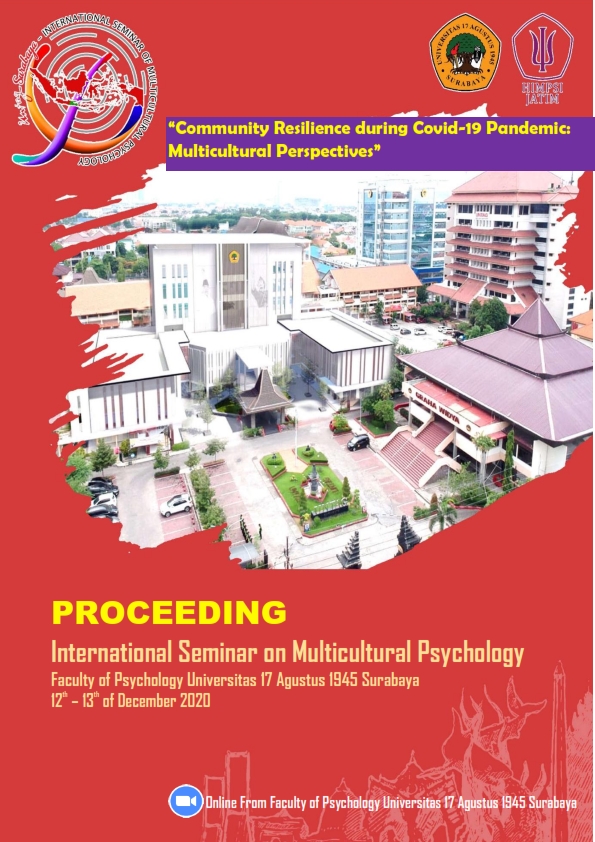Do University Students Experience Psychological Distress During the Covid-19 Pandemic?
Abstract
University students are in the period of emerging adulthood that are vulnerable to experience psychological distress compared to other populations. They receive various pressures from social contexts such as academic demands, relationship issues, or career problems. Understanding student psychological distress is important as its impact is debilitating student academic life and well-being. The focus of this study is to identify the prevalence of student psychological distress of University “X” in Jakarta. A total of 514 students was involved in this survey using a convenience sampling. The Hopskin Symptom Checklist-25 was used as a screening tools to assess depression and anxiety. The result showed the prevalence of students who experienced depression and anxiety based on the demographic characteristics such as gender, year entry, and household status. More than 80% students were indicated as a high-risk group either in depression or anxiety. This study implies that the university should promote more prevention and intervention programs to help students in dealing with psychological distress.
Keywords: anxiety; depression; psychological distress; university students
Downloads
References
Adlaf, E. M., Gliksman, L., Demers, A., & Newton-Taylor, B. (2001). The prevalence of elevated psychological distress among canadian undergraduates: Findings from the 1998 Canadian campus survey. Journal of the American College Health Association, 50(2), 67–72. https://doi.org/10.1080/07448480109596009
Auerbach, R. P., Alonso, J., Axinn, W. G., Cuijpers, P., Ebert, D. D., Green, J. G., … Bruffaerts, R. (2016). Mental disorders among college students in the World Health Organization World Mental Health Surveys. Psychological Medicine, Vol. 46, pp. 2955–2970. https://doi.org/10.1017/S0033291716001665
Auerbach, Randy P., Mortier, P., Bruffaerts, R., Alonso, J., Benjet, C., Cuijpers, P., … Kessler, R. C. (2018). WHO world mental health surveys international college student project: Prevalence and distribution of mental disorders. Journal of Abnormal Psychology, 127(7), 623–638.
Do University Students Experience Psychological Distress During
the Covid-19 Pandemic?
https://doi.org/10.1037/abn0000362
Bayram, N., & Bilgel, N. (2008). The prevalence and socio-demographic correlations of depression, anxiety and stress among a group of university students. Social Psychiatry and Psychiatric Epidemiology, 43(8), 667–672. https://doi.org/10.1007/s00127-008-0345-x
Bernhardsdóttir, J., & Vilhjálmsson, R. (2013). Psychological distress among university female students and their need for mental health services. Journal of Psychiatric and Mental Health Nursing, 20(8), 672–678. https://doi.org/10.1111/jpm.12002
Drapeau, A., Marchand, A., & Beaulieu-Prevost, D. (2012). Epidemiology of Psychological Distress. In Mental Illnesses - Understanding, Prediction and Control. https://doi.org/10.5772/30872
Hakami, R. (2018). Prevalence of psychological distress among undergraduate students at Jazan University: A cross-sectional study. Saudi Journal of Medicine and Medical Sciences, 6(2), 82. https://doi.org/10.4103/sjmms.sjmms_73_17
Heath, S., & Kenyon, L. (2001). Single Young Professionals and Shared Household Living. Journal of Youth Studies, 4(1), 83–100. https://doi.org/10.1080/13676260120028565
Keyes, C. L. M., Eisenberg, D., Perry, G. S., Dube, S. R., Kroenke, K., & Dhingra, S. S. (2012). The relationship of level of positive mental health with current mental disorders in predicting suicidal behavior and academic impairment in college students. Journal of American College Health, 60(2), 126–133. https://doi.org/10.1080/07448481.2011.608393
Knapstad, M., Sivertsen, B., Knudsen, A. K., Smith, O. R. F., Aarø, L. E., Lønning, K. J., & Skogen, J. C. (2019). Trends in self-reported psychological distress among college and university students from 2010 to 2018. Psychological Medicine, 1–9. https://doi.org/10.1017/s0033291719003350
Payton, A. R. (2009). Mental health, mental illness, and psychological distress: Same continuum or distinct phenomena? Journal of Health and Social Behavior, 50(2), 213–227. https://doi.org/10.1177/002214650905000207
Ridner, S. H. (2004). Psychological distress: Concept analysis. Journal of Advanced Nursing, Vol. 45, pp. 536–545. https://doi.org/10.1046/j.1365-2648.2003.02938.x
Stallman, H. M. (2010). Psychological distress in university students: A comparison with general population data. Australian Psychologist, 45(4), 249–257. https://doi.org/10.1080/00050067.2010.482109
Turnip, S. S., & Hauff, E. (2007). Household roles, poverty and psychological distress in internally displaced persons affected by violent conflicts in Indonesia. Social Psychiatry and Psychiatric Epidemiology, 42(12), 997–1004. https://doi.org/10.1007/s00127-007-0255-3
Wang, C., Pan, R., Wan, X., Tan, Y., Xu, L., Ho, C. S., & Ho, R. C. (2020). Immediate psychological responses and associated factors during the initial stage of the 2019 coronavirus disease (COVID-19) epidemic among the general population in China. International Journal of Environmental Research and Public Health, 17(5). https://doi.org/10.3390/ijerph17051729
Winokur, A., Winokur, D. F., Rickels, K., & Cox, D. S. (1984). Symptoms of emotional distress in a family planning service: Stability over a four-week period. British Journal of Psychiatry, 144(4), 395–399. https://doi.org/10.1192/bjp.144.4.395




_(1).jpg)



